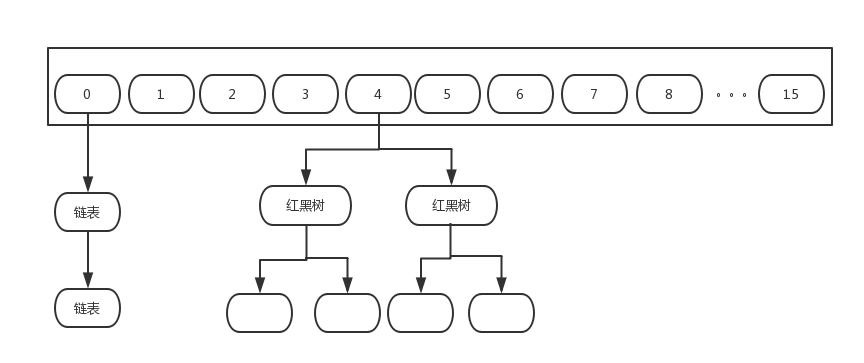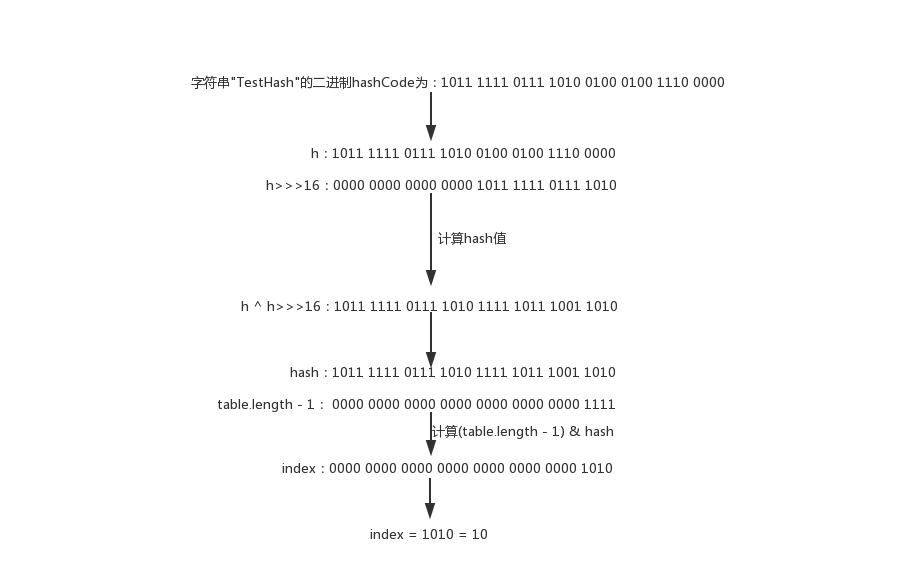源码分析--HashMap(JDK1.8)
在JDK1.8中对HashMap的底层实现做了修改。本篇对HashMap源码从核心成员变量到常用方法进行分析。
HashMap数据结构如下:

先看成员变量:
1、底层存放数据的是Node<K,V>[]数组,数组初始化大小为16。
/** * The default initial capacity - MUST be a power of two. */ static final int DEFAULT_INITIAL_CAPACITY = 1 << 4; // aka 16
2、Node<K,V>[]数组最大容量
/** * The maximum capacity, used if a higher value is implicitly specified * by either of the constructors with arguments. * MUST be a power of two <= 1<<30. */ static final int MAXIMUM_CAPACITY = 1 << 30;
3、负载因子0.75。也就是如果默认初始化,HashMap在size = 16*0.75 = 12时,进行扩容。
/** * The load factor used when none specified in constructor. */ static final float DEFAULT_LOAD_FACTOR = 0.75f;
4、将链表转化为红黑数的阀值。
/** * The bin count threshold for using a tree rather than list for a * bin. Bins are converted to trees when adding an element to a * bin with at least this many nodes. The value must be greater * than 2 and should be at least 8 to mesh with assumptions in * tree removal about conversion back to plain bins upon * shrinkage. */ static final int TREEIFY_THRESHOLD = 8;
5、红黑树节点转换为链表的阀值
/** * The bin count threshold for untreeifying a (split) bin during a * resize operation. Should be less than TREEIFY_THRESHOLD, and at * most 6 to mesh with shrinkage detection under removal. */ static final int UNTREEIFY_THRESHOLD = 6;
6、转红黑树时,table的最小长度
/** * The smallest table capacity for which bins may be treeified. * (Otherwise the table is resized if too many nodes in a bin.) * Should be at least 4 * TREEIFY_THRESHOLD to avoid conflicts * between resizing and treeification thresholds. */ static final int MIN_TREEIFY_CAPACITY = 64;
介绍一下HashMap用hash值定位数组index的过程:
//HahsMap中的静态方法
static final int hash(Object key) {
int h;
return (key == null) ? 0 : (h = key.hashCode()) ^ (h >>> 16);
}
//定位计算
int index = (table.length - 1) & hash
- 先得到key的hashCode值
- 再将hashCode值与hashCode无符号右移16位的值进行按位异或运算。得到hash值
- 将(table.length - 1) 与 hash值进行与运算。定位数组index
给一个长度为16的数组,以"TestHash"为key,进行定位的过程实例:

HashMap中Node就是放入的数据节点,代码定义为:
static class Node<K,V> implements Map.Entry<K,V> { final int hash; final K key; V value; Node<K,V> next; }
Node节点保存key的hash值和K--V,借助next可实现链表。
红黑树封装为TreeNode节点:
static final class TreeNode<K,V> extends LinkedHashMap.Entry<K,V> { TreeNode<K,V> parent; // red-black tree links TreeNode<K,V> left; TreeNode<K,V> right; TreeNode<K,V> prev; // needed to unlink next upon deletion boolean red; TreeNode(int hash, K key, V val, Node<K,V> next) { super(hash, key, val, next); }
介绍get()方法:
final Node<K,V> getNode(int hash, Object key) { Node<K,V>[] tab; Node<K,V> first, e; int n; K k; if ((tab = table) != null && (n = tab.length) > 0 && (first = tab[(n - 1) & hash]) != null) { if (first.hash == hash && // always check first node ((k = first.key) == key || (key != null && key.equals(k)))) return first; if ((e = first.next) != null) { if (first instanceof TreeNode) return ((TreeNode<K,V>)first).getTreeNode(hash, key); do { if (e.hash == hash && ((k = e.key) == key || (key != null && key.equals(k)))) return e; } while ((e = e.next) != null); } } return null; }
- index定位,得到该索引上的Node节点,赋值给first
- 对first节点进行判断,如果是要找的元素,直接返回
- first节点的next不为空,继续找
- 如果first节点是红黑树,调用getTreeNode()获取值。
- 不是红黑树,只能是链表。从头遍历,找到就返回。
上面对于红黑树取值的getTreeNode()方法,看一下红黑树的遍历做法:
final TreeNode<K,V> find(int h, Object k, Class<?> kc) { TreeNode<K,V> p = this; do { int ph, dir; K pk; TreeNode<K,V> pl = p.left, pr = p.right, q; if ((ph = p.hash) > h) p = pl; else if (ph < h) p = pr; else if ((pk = p.key) == k || (k != null && k.equals(pk))) return p; else if (pl == null) p = pr; else if (pr == null) p = pl; else if ((kc != null || (kc = comparableClassFor(k)) != null) && (dir = compareComparables(kc, k, pk)) != 0) p = (dir < 0) ? pl : pr; else if ((q = pr.find(h, k, kc)) != null) return q; else p = pl; } while (p != null); return null; }
- 从do-while循环里的第一个if开始。如果当前节点的hash比传入的hash大,往p节点的左边遍历
- 如果当前节点的hash比传入的hash小,往p节点的右边遍历
- 如果key值相同,就找到节点了。返回
- 左节点为空,转到右边遍历
- 右节点为空,转到左边
- 如果传入key实现了Comparable接口。就将传入key与p节点key进行比较,根据比较结果选择向左或向右遍历
- 没有实现接口,直接向右遍历,找到就返回
- 没找到,向左遍历
介绍put()方法:
final V putVal(int hash, K key, V value, boolean onlyIfAbsent, boolean evict) { Node<K,V>[] tab; Node<K,V> p; int n, i; if ((tab = table) == null || (n = tab.length) == 0) n = (tab = resize()).length; if ((p = tab[i = (n - 1) & hash]) == null) tab[i] = newNode(hash, key, value, null); else { Node<K,V> e; K k; if (p.hash == hash && ((k = p.key) == key || (key != null && key.equals(k)))) e = p; else if (p instanceof TreeNode) e = ((TreeNode<K,V>)p).putTreeVal(this, tab, hash, key, value); else { for (int binCount = 0; ; ++binCount) { if ((e = p.next) == null) { p.next = newNode(hash, key, value, null); if (binCount >= TREEIFY_THRESHOLD - 1) // -1 for 1st treeifyBin(tab, hash); break; } if (e.hash == hash && ((k = e.key) == key || (key != null && key.equals(k)))) break; p = e; } } if (e != null) { // existing mapping for key V oldValue = e.value; if (!onlyIfAbsent || oldValue == null) e.value = value; afterNodeAccess(e); return oldValue; } } ++modCount; if (++size > threshold) resize(); afterNodeInsertion(evict); return null; }
- table为null,初始化
- 定位到数组index,若该位置为空,直接放
- 如果该位置上不为空,且hash和key与传入的值相同,说明key重复,直接将该节点赋值给e,结束循环
- 如果该index上的节点是红黑树,调用putTreeVal()方法
- 不是红黑树,只能是链表,遍历整个链表
- 找到最后一个节点,在这个节点后面以k--v新增一个节点。
- 判断链表长度,binCount达到7,也就是长度达到8。转为红黑树。
- 遍历过程中,如果找到了相同key,就跳出循环。
- 如果e不为空,说明遍历结束后存在key重复的节点。做值覆盖
- 扩容判断
分析红黑树插入方法putTreeVal():
final TreeNode<K,V> putTreeVal(HashMap<K,V> map, Node<K,V>[] tab, int h, K k, V v) { Class<?> kc = null; boolean searched = false; TreeNode<K,V> root = (parent != null) ? root() : this; for (TreeNode<K,V> p = root;;) { int dir, ph; K pk; if ((ph = p.hash) > h) dir = -1; else if (ph < h) dir = 1; else if ((pk = p.key) == k || (k != null && k.equals(pk))) return p; else if ((kc == null && (kc = comparableClassFor(k)) == null) || (dir = compareComparables(kc, k, pk)) == 0) { if (!searched) { TreeNode<K,V> q, ch; searched = true; if (((ch = p.left) != null && (q = ch.find(h, k, kc)) != null) || ((ch = p.right) != null && (q = ch.find(h, k, kc)) != null)) return q; } dir = tieBreakOrder(k, pk); } TreeNode<K,V> xp = p; if ((p = (dir <= 0) ? p.left : p.right) == null) { Node<K,V> xpn = xp.next; TreeNode<K,V> x = map.newTreeNode(h, k, v, xpn); if (dir <= 0) xp.left = x; else xp.right = x; xp.next = x; x.parent = x.prev = xp; if (xpn != null) ((TreeNode<K,V>)xpn).prev = x; moveRootToFront(tab, balanceInsertion(root, x)); return null; } } }
- 查找root根节点
- 从root节点开始遍历
- 如果当前节点p的hash大于传入的hash值,记dir为-1,代表向左遍历。
- 小于,记1,代表向右遍历
- 如果key相同,直接返回
- 如果key所属的类实现Comparable接口,或者key相等。先从p的左节点、右节点分别调用find(),找到就返回。
- 没找到,比较p和传入的key值,结果记为dir
- 根据dir选择向左或向右遍历
- 依次遍历,直到为null,表示达到最后一个节点,插入新节点
- 调整位置
分析HashMap扩容方法:
final Node<K,V>[] resize() { Node<K,V>[] oldTab = table; int oldCap = (oldTab == null) ? 0 : oldTab.length; int oldThr = threshold; int newCap, newThr = 0; if (oldCap > 0) { if (oldCap >= MAXIMUM_CAPACITY) { threshold = Integer.MAX_VALUE; return oldTab; } else if ((newCap = oldCap << 1) < MAXIMUM_CAPACITY && oldCap >= DEFAULT_INITIAL_CAPACITY) newThr = oldThr << 1; // double threshold } else if (oldThr > 0) // initial capacity was placed in threshold newCap = oldThr; else { // zero initial threshold signifies using defaults newCap = DEFAULT_INITIAL_CAPACITY; newThr = (int)(DEFAULT_LOAD_FACTOR * DEFAULT_INITIAL_CAPACITY); } if (newThr == 0) { float ft = (float)newCap * loadFactor; newThr = (newCap < MAXIMUM_CAPACITY && ft < (float)MAXIMUM_CAPACITY ? (int)ft : Integer.MAX_VALUE); } threshold = newThr; @SuppressWarnings({"rawtypes","unchecked"}) Node<K,V>[] newTab = (Node<K,V>[])new Node[newCap]; table = newTab; if (oldTab != null) { for (int j = 0; j < oldCap; ++j) { Node<K,V> e; if ((e = oldTab[j]) != null) { oldTab[j] = null; if (e.next == null) newTab[e.hash & (newCap - 1)] = e; else if (e instanceof TreeNode) ((TreeNode<K,V>)e).split(this, newTab, j, oldCap); else { // preserve order Node<K,V> loHead = null, loTail = null; Node<K,V> hiHead = null, hiTail = null; Node<K,V> next; do { next = e.next; if ((e.hash & oldCap) == 0) { if (loTail == null) loHead = e; else loTail.next = e; loTail = e; } else { if (hiTail == null) hiHead = e; else hiTail.next = e; hiTail = e; } } while ((e = next) != null); if (loTail != null) { loTail.next = null; newTab[j] = loHead; } if (hiTail != null) { hiTail.next = null; newTab[j + oldCap] = hiHead; } } } } } return newTab; }
- 通过一系列判断,确认新table的容量
- 构造一个新容量的Node数组,赋值给table
- 遍历旧table数组
- 如果节点是单节点,直接定位到新数组对应的index位置下
- 如果是红黑树,调用split方法
- 遍历链表。
- 如果e的hash值与老数组容量取与运算,值为0。索引位置不变
- 如果e的hash值与老数组容量取与运算,值为1。这在新数组中索引的位置为老数组索引 + 老数组容量。
- 链表放置
简要分析多线程下HashMap死循环问题:
JDK1.7HashMap扩容时,对于链表位置变化,采用头插法进行操作。多线程下容易形成环形链表,造成死循环。
JDK1.8时,会对于链表hash值与容量的计算结果。分成两部分,并改为插入到链表尾部。1.8以后不会再有死循环问题,只是有可能重复放置导致数据丢失。HashMap本身线程不安全的特性并没有改变。




 浙公网安备 33010602011771号
浙公网安备 33010602011771号